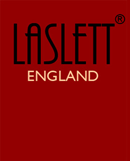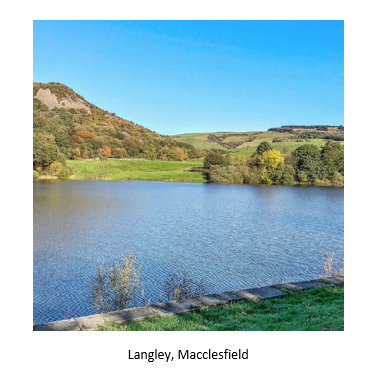Macclesfield in Cheshire in the North of England is where the making of a Laslett England silk screen-printed scarf begins. Macclesfield has been synonymous with silk printing since 1743, it sits at the end of the silk road, nestled in the foothills of the Pennines, close to Macclesfield which was once the centre of the English silk weaving industry and the world’s largest producer of finished silk. Macclesfield also has a wonderful Silk Museum.
Just two miles outside of town is the village of Langley, where Adamley Textiles is located. The site is close to a water supply, the river Bollin, and thanks to this extraordinary position Adamley has been able to source water from its very own reservoir (as shown in the image above), producing printed fabric here for now over 50 years. Adamley is highly renowned in the high-end accessories market for its bespoke silk scarf printing service. Printed in-house, scarves are carefully crafted from the finest quality silk twill. Adamley have been printing on silk since the 1970’s and continue to work only with natural fibres to achieve the most premium quality product. Adamley is committed to keeping the tradition of silk screen printing on silk fabric alive and are one of the few silk printers in the UK to still practice this incredibly skilful technique. Screen printing on silk is a slow and meticulous process which involves hand printing colours, layer by layer, screen after screen. It’s one that requires great precision to yield the most elegant, vibrant results. Bespoke designs are hand printed on to fabric with great precision by their team of highly skilled printers, using in-house produced dyes.
Textile designer, Melanie Laslett creates her prints in her home studio in Hastings, East Sussex. To create a scarf design for the screen print process Melanie works to the technical requirements laid out by Adamley, which means the design needs to be of the highest quality with imagery that can be re-produced in print and of a resolution high enough 600dpi (dots per inch) to achieve a perfect impression on fabric.
The maritime inspired artwork is hand painted using designers’ gouache onto a black painted background. Melanie paints the various elements of the design including a border design which will frame the finished scarf. All these ‘ingredients’ are scanned into the computer using Adobe Photoshop. At this stage Melanie has already decided that this scarf is going to be a silk bandana, square in shape with a finished size of 57 x 57 cms. In Photoshop Melanie creates the canvas size (larger than the finished scarf) to allow for a small % of shrinkage that typically occurs during the printing and finishing plus to allow for a hem allowance once the edges are sewn.
Once the design is completed, it is sent as a digital file to Adamley. From there the design is engraved onto a high precision mesh stretched under tension and mounted on a wooden frame, transferred to the screen using laser technology as shown below.
The screen is ready but before printing can commence the silk fabric needs to be pre-dyed and the printing ink needs to be mixed. The Marettimo silk square will be discharged printed onto a silk twill using one screen as it is a one colour print. The discharge ink enables a light-coloured image to be printed onto a dark background as well as to preserve the hand-painted detail of the artwork. The silk twill is pre-dyed to match a colour swatch called madder blue as below.
This is where in-house produced colours and dyes are prepared for screen printing
The silk fabric is secured to the print bed and the screen is lined up precisely to print the pattern through the screen with the automated squeegee.
The fabric is hung to dry after being printed – at this stage the inks printed onto the fabric will appear muted or dull until they have been cured. Once printed, the colours are then cured through steaming, and the fabric is then finished by washing to soften the fibres to achieve the most premium product.
During the final finishing, the colours are revealed. Once cured, the colours really start to sing and show how the heat and washing processes have activated the discharge printing to replace the muted print colour with the final off-white colour contrasted with the madder blue silk – now it resembles a scarf, the fabric has a beautiful sheen and a soft hand feel.
Above and below, the finished ‘Marettimo’ silk bandana – 57 x 57cms – 100% silk twill
A true measure of a silk scarf’s authenticity is the hand-rolled hemming for the perfect luxury finish.
Designed in England, Made in Macclesfield.
And finally, the silk screen is stored in a library along with all the other customer screens. The Laslett England screen is reusable at any time to print another run of scarves. Early in 2023 the screen was used for a second time to print Marettimo bandana in a red colourway as below.

















